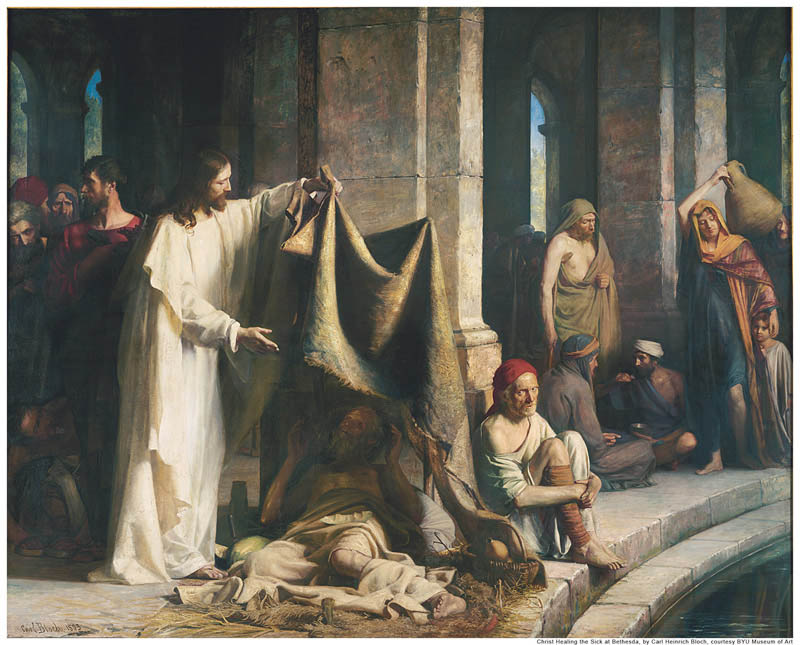One of my favorite stories of Jesus’ many services to those in need is that of his healing of the blind man, Bartimaeus.
46 And they came to Jericho: and as he went out of Jericho with his disciples and a great number of people, blind Bartimaeus, the son of Timaeus, sat by the highway side begging.
47 And when he heard that it was Jesus of Nazareth, he began to cry out, and say, Jesus, thou Son of David, have mercy on me.
48 And many charged him that he should hold his peace: but he cried the more a great deal, Thou Son of David, have mercy on me.
49 And Jesus stood still, and commanded him to be called. And they call the blind man, saying unto him, Be of good comfort, rise; he calleth thee.
50 And he, casting away his garment, rose, and came to Jesus.
51 And Jesus answered and said unto him, What wilt thou that I should do unto thee? The blind man said unto him, Lord, that I might receive my sight.
52 And Jesus said unto him, Go thy way; thy faith hath made thee whole. And immediately he received his sight, and followed Jesus in the way. (Mark 10)
 We usually read this story and focus on the healing, but it’s the other parts of the story that capture my attention. To fully understand the power of this moment in the Savior’s life, we must remember that Bartimaeus was begging because a man who was blind was not normally allowed to earn a living in those days. Treatment of those with special needs was very different then. They were believed to be unimportant and incompetent to do anything of value, and so they begged and relied on others for their care. It was for this reason, this lack of perceived importance, that people tried to stop Bartimaeus from “bothering” Jesus as he came through town.
We usually read this story and focus on the healing, but it’s the other parts of the story that capture my attention. To fully understand the power of this moment in the Savior’s life, we must remember that Bartimaeus was begging because a man who was blind was not normally allowed to earn a living in those days. Treatment of those with special needs was very different then. They were believed to be unimportant and incompetent to do anything of value, and so they begged and relied on others for their care. It was for this reason, this lack of perceived importance, that people tried to stop Bartimaeus from “bothering” Jesus as he came through town.
We can see his great faith, however. He didn’t stop calling to Jesus because he knew Jesus could give him his sight, and his sight, in that day, was not just physical vision, but a way into dignity and a life of purpose that society wouldn’t give him otherwise.
Jesus heard his call and asked his disciples to call the man to him. Bartimaeus may have hesitated because he had to be reassured that it was okay to approach. Notice what the Savior did when the man came to him. He spoke to the man respectfully, probably not something commonly done to him, and asked, essentially, “How can I serve you?”
Then, Jesus said, and certainly many were listening to his words, that the man’s faith had made him whole. Remember this is a man society felt to be unimportant and incapable of great things. Jesus informed those around him that Bartimaeus did indeed have value and skills—he had the gift of faith so great it could heal him. This gave the man instant credibility to those around him, and perhaps caused those who watched to wonder about their previous assessment of the blind man. Did they go home and feel guilty about how they had treated him in the past? Were they sorry they’d tried to keep him from approaching the Savior? Did they treat the next blind man they saw with greater respect because of the example the Savior set for them that day?
There is much more to this story than a healing, as great as that healing was. We have here a powerful example of how the Savior expects us to treat everyone around us, whether or not we can see their value. The Savior sees it and God sees it. The Savior is no longer on earth to walk up to the modern day Bartimaeus’. It’s now up to us to treat everyone with dignity and respect and to see in them what God sees.
About Terrie Lynn Bittner
The late Terrie Lynn Bittner—beloved wife, mother, grandmother, and friend—was the author of two homeschooling books and numerous articles, including several that appeared in Latter-day Saint magazines. She became a member of the Church at the age of 17 and began sharing her faith online in 1992.






